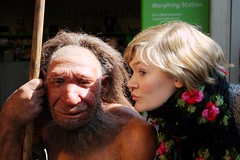Goodbye to the gatherers, welcome to the web: mammoths and modernity.
Imagine the first farmers: they lived in a society of hunters and gatherers. Every so often, you’d pack up your stuff and move along, to follow your food. Find new things to eat, because you’ve exhausted the place you lived in.
 The farmers introduced a new way of thinking: what if we could just grow our food in one place? That would save the effort of travelling around. So they started experimenting: sowing seeds, taking care of the young sprouts, trying to cultivate their plants. Until it was harvest time: reap the benefits of your labour, indulge in cornucopia for a while, store a bit, and start working on the next cycle.
The farmers introduced a new way of thinking: what if we could just grow our food in one place? That would save the effort of travelling around. So they started experimenting: sowing seeds, taking care of the young sprouts, trying to cultivate their plants. Until it was harvest time: reap the benefits of your labour, indulge in cornucopia for a while, store a bit, and start working on the next cycle.
The hunters and gatherers must have looked upon those folks as weird people: building houses ("sure, nice to live in but not very practical on your travels!"), creating ploughs and tools ("great way to move dirt, but how are you going to catch a mammoth or pluck a berry with that?"), storing food in storages ("won’t the mice and the rats just run with it?"). The hackers and nerds of their times, saying "go ahead and chase your mammoth, I’ll see you around, next Summer".
The farmers prevailed. They changed the way society works in most places on the world. We try to stick to where we are, and we even make rituals and routines around that, to affirm our convictions and location. And most of us are no longer involved in producing food, but rather in pursuing other goals.
I’m working in the field of international development collaboration. I often feel like a farmer, talking to hunters and gatherers, about what "web 2.0" is really about. Oh, he’s a techie, an engineer. But I’m experimenting with ways to grow compassion, engagement, collaboration. Online communities? Blogs and bookmarks? RSS and wikis? Social networking? Sure, but won’t the rats just eat your products while you’re having a party?
We don’t eat a lot of Mammoth Burger these days. And we could cultivate collaboration towards a common goal, without sacrifice or giving up (a lot of) our current live. We can build a global society based on solidarity, without loosing identity or community.
Lets move from chasing to cultivating.
(photo: CC-BY-SA-NC-20 by Poo-tee-weet?)
Flying saucers, flow and serendipity shape the web
Recently, my work has moved again towards "concept" and "facilitation", into the realm of the unknown, the things to be discovered. Especially around online collaboration, platforms to facilitate that, and internet strategies and architectures to support such processes: Web of Change, WijZijnMedia, NABUUR, Internationale Samenwerking 2.0 (in Dutch for now). It’s all about new community-organising strategies and tactics, and I love it: a potent mix of "where do we go from here" and "what will we have built by the end of today". Pragmatic idealism: punk+utopia with web 2.0+mobile as catalyst, or perhaps: "do it yourself serendipity". But also: how to let flying saucers get you there. Mihaly Csikszentmihalyi’s talk at TED and Matt Leacock’s Google Tech Talk guide me.
Creating wire frames and mockups
 Communicating web concepts for user experience and site structure is a challenge. Wire frames and interactive prototypes are great for this, and over the years, I have been using those with many designers and developers in a variety of web projects. But creating and sharing such mockups still is a laborious task, so I went around the web again to look for a tool that truly makes that task easier. Pidoco seems to offer the best way forward for me.
Communicating web concepts for user experience and site structure is a challenge. Wire frames and interactive prototypes are great for this, and over the years, I have been using those with many designers and developers in a variety of web projects. But creating and sharing such mockups still is a laborious task, so I went around the web again to look for a tool that truly makes that task easier. Pidoco seems to offer the best way forward for me.
Curing “Data Hugging Disorder”
Last Friday, the 1%Club held their (first, probably not last) 1%EVENT, about “international development cooperation 2.0”. I facilitated a session on “connecting the platforms”, to pave the (technical) way towards a cure for what Ushahidi’s Juliana Rotich aptly referred to as “Data Hugging Disorder“. It resulted in a positive discussion with several people of organisations that build or host online platforms. Coming Monday, I hope the discussion continues at a meeting in The Hague about a possible Dutch IS-Hub.
Clay Shirky as my Sound Byte Hero
I haven’t managed to write (publicly) for some time: new projects kept me busy, either launching, or preparing. But thanks to a tweet by Planspark, I read (yet another) piece by someone who is becoming my personal “Sound Byte Hero”: Clay Shirky. At the moment, Siegfried Woldhek and I are preparing a position paper on how International Development Cooperation will change, as part of a series of debates with existing organisations and the Minister for Development Cooperation here in The Netherlands. So when my friend Tim Bonnemann send out a tweet today “Must-read of the day: Clay Shirky’s “Newspapers and Thinking the Unthinkable”, I summarised the take-away quotes for me.
Passion, the Participatory Web, and the Potentials of ICT
 “The Participatory Web – New Potentials of ICT in Rural Areas”I haven’t been able to go to the Web2ForDev meetings so far, but have encountered the typical problems of ICT and knowledge sharing in rural areas around the world. So when Christian Kreutz approached me to contribute to a publication by GTZ, the Deutsche Gesellschaft for Technische Zusammenarbeit (German Technical Cooperation), on how NABUUR offered a new way of connecting people and letting knowledge flow, I got in touch with Raul Caceres, who has done amazing work as a NABUUR volunteer, resulting in a United Nations Volunteer of the Year Award, and an invitation to speak at the Nobel Summit on Public Services. Together, we wrote one of the seven articles in “The Participatory Web – New Potentials of ICT in Rural Areas”.
“The Participatory Web – New Potentials of ICT in Rural Areas”I haven’t been able to go to the Web2ForDev meetings so far, but have encountered the typical problems of ICT and knowledge sharing in rural areas around the world. So when Christian Kreutz approached me to contribute to a publication by GTZ, the Deutsche Gesellschaft for Technische Zusammenarbeit (German Technical Cooperation), on how NABUUR offered a new way of connecting people and letting knowledge flow, I got in touch with Raul Caceres, who has done amazing work as a NABUUR volunteer, resulting in a United Nations Volunteer of the Year Award, and an invitation to speak at the Nobel Summit on Public Services. Together, we wrote one of the seven articles in “The Participatory Web – New Potentials of ICT in Rural Areas”.
